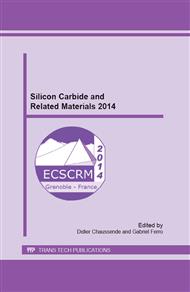[1]
L. Liao, X. Duan, Graphene-dielectric integration for graphene transistors, Mater. Sci. Eng. R 70 (2010) 354-370.
Google Scholar
[2]
T. Hopf, K. Vassilevski, E. Escobedo-Cousin, N.G. Wright, A.G. O'Neill, A.B. Horsfall, J.P. Goss, A. Barlow, G.H. Wells, M.R.C. Hunt, Optimizing the vacuum growth of epitaxial graphene on 6H-SiC, Mater. Sci. Forum 778 (2014) 1154-1157.
DOI: 10.4028/www.scientific.net/msf.778-780.1154
Google Scholar
[3]
J.A. Robinson, M. LaBella III, K.A. Trumbull, X. Weng, R. Cavelero, T. Daniels, Z. Hughes, M. Hollander, M. Fanton, D. Snyder, Epitaxial graphene materials integration: effects of dielectric overlayers on structural and electronic properties, ACS Nano 4 (2010).
DOI: 10.1021/nn1003138
Google Scholar
[4]
D.K. Schroder, Semiconductor material and device characterization, Third ed., Wiley-Interscience, New Jersey, (2006).
Google Scholar
[5]
D.B. Farmer, H. Chiu, Y. Lin, K.A. Jenkins, F. Xia, P. Avouris, Utilization of a buffered dielectric to achieve high field-effect carrier mobility in graphene transistors, Nano Lett. 9 (2009) 4474-4478.
DOI: 10.1021/nl902788u
Google Scholar
[6]
K.N. Parrish, D. Akinwande, Impact of contact resistance on the transconductance and linearity of graphene transistors, Appl. Phys. Lett. 98 (2011) 183505.
DOI: 10.1063/1.3665406
Google Scholar
[7]
V.K. Nagareddy, I.P. Nikitina, D.K. Gaskill, J.L. Tedesco, R.L. Myers-Ward, C.R. Eddy, J.P. Goss, N.G. Wright, A.B. Horsfall, High temperature measurements of metal contacts on epitaxial graphene, Appl. Phys. Lett. 99 (2011) 073506.
DOI: 10.1063/1.3627167
Google Scholar
[8]
N. Park, B. Kim, J. Lee, J. Kim, Influence of metal work function on the position of the Dirac point of graphene field-effect transistors, Appl. Phys. Lett. 95 (2009) 243105.
DOI: 10.1063/1.3274039
Google Scholar
[9]
W.J. Yu, L. Liao, S.H. Chae, Y.H. Lee, X. Duan, Toward tunable band gap and tunable Dirac point in bilayer graphene with molecular doping, Nano Lett. 11 (2011) 4759-4763.
DOI: 10.1021/nl2025739
Google Scholar
[10]
A. Deshpande, W. Bao, Z. Zhao, C.N. Lau, B.J. LeRoy, Mapping the Dirac point in gated bilayer graphene, Appl. Phys. Lett. 95 (2009) 243502.
DOI: 10.1063/1.3275755
Google Scholar
[11]
K. Xu, C. Zeng, Q. Zhang, R. Yan, P. Ye, K. Wang, A.C. Seabaugh, H.G. Xing, J.S. Suehle, C.A. Richter, D.J. Gundlach, N.V. Nguyen, Direct measurement of Dirac point energy at the graphene/oxide interface, Nano Lett. 13 (2013) 131-136.
DOI: 10.1021/nl303669w
Google Scholar


